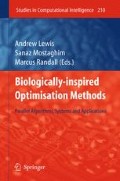Abstract
A method increasingly used to uniquely identify objects (be they pieces of luggage, transported goods or inventory items in shops and warehouses), is Radio Frequency IDentification (RFID). One of the most important components of RFID systems is the antenna and its design is critical to the utility of such tracking systems. Design engineers have traditionally constructed small antennas using their knowledge and intuition, as there is no simple analytical solution relating antenna structure to performance. This, however, does not guarantee optimal results, particularly for larger, more complex antennas. The problem is ideally suited to automated methods of optimisation. This chapter presents an overview of the automatic design of antennas using the meta-heuristic known as Ant Colony Optimisation (ACO). Apart from a description of the necessary mechanics ACO needs to effectively solve this problem, a novel local search refinement operator and a multi-objective version of the problem are also described. The latter is used to optimise both antenna efficiency and resonant frequency. Computational results for a range of antenna sizes show that ACO is a very effective design tool for RFID antennas.
Access this chapter
Tax calculation will be finalised at checkout
Purchases are for personal use only
Preview
Unable to display preview. Download preview PDF.
References
Angus, D.: Multiple objective ant colony optimisation. Swarm Intelligence 3, 69–85 (2009)
Burke, G., Poggio, A., Logan, J., Rockway, J.: NEC - Numerical electromagnetics code for antennas and scattering. Antennas and Propagation Society International Symposium 17, 147–150 (1979)
Collette, Y., Siarry, P.: Multiobjective Optimization. Springer, Heidelberg (2003)
Dorigo, M.: Optimization, learning and natural algorithms. PhD. thesis, Politecnico di Milano (1992)
Dorigo, M., Di Caro, G.: The ant colony optimization meta-heuristic. In: Corne, D., Dorigo, M., Glover, F. (eds.) New Ideas in Optimization, pp. 11–32. McGraw-Hill, London (1999)
Dorigo, M., Gambardella, L.: Ant Colony System: A cooperative learning approach to the trav eling salesman problem. IEEE Transactions on Evolutionary Computation 1, 53–66 (1997)
Galehdar, A., Thiel, D., O’Keefe, S.: Antenna efficiency calculations for electrically small, RFID antennas. IEEE Antenna and Wireless Propagation (in press) (2007)
Galehdar, A., Thiel, D., O’Keefe, S., Kingsley, S.: Efficiency variations in electrically small, meander line RFID antennas. In: Proceedings of IEEE Antenna Propagation Symposium (2007)
Hayes, B.: How to avoid yourself. American Scientist 86, 314–319 (1998)
Koski, J.: Defectiveness of weighting method in multicriterion optimization of structures. Communications in Applied Numerical Methods 1, 333–337 (1985)
Mansfield, M.: Monte Carlo studies of polymer chain dimensions in the melt. The Journal of Chemical Physics 77(3), 1554–1559 (1982)
Oberdorf, R., Ferguson, A., Jacobsen, J., Kondev, J.: Secondary structures in long compact polymers. Physical Review E 74 (2006)
Randall, M., Lewis, A.: A parallel implementation of ant colony optimization. Journal of Parallel and Distributed Computing 62, 1421–1432 (2002)
Randall, M., Lewis, A., Galehdar, A., Thiel, D.: Using ant colony optimisation to improve the efficiency of small meander line RFID antennas. In: 3rd IEEE International e-Science and Grid Computing Conference, pp. 345–351. IEEE Computer Society, Washington (2007), http://dx.doi.org/10.1109/E-SCIENCE.2007.82
Seshagiri Rao, K., Nikitin, P., Lam, S.: Antenna design for UHF RFID tags: A review and a practical application. IEEE Transactions on Antennas Propagation 53, 3870–3876 (2005)
Sokal, A.: Monte carlo methods for the self avoiding walk. Monte Carlo and Molecular Dynamics Simulations in Polymer Science pp. 47–124 (1994)
Sokal, A.: Monte carlo methods for the self-avoiding walk. Nuclear Physics B Proceedings Supplement 47, 172–179 (1996)
Stockman, H.: Communication by means of reflected power. In: Proceedings of the Institute of Radio Engineers, pp. 1196–1204 (1948)
Stützle, T.: The Max-Min Ant System and local search for combinatorial optimization problems. In: Voss, S., Martello, S., Osman, I., Roucairol, C. (eds.) Meta-heuristics: Advances and Trends in Local Search Paradigms for Optimization, pp. 313–329. Kluwer, Dordrecht (1999)
Stützle, T., Hoos, H.: MAX-MIN Ant System and local search for the traveling salesman problem. In: IEEE International Conference on Evolutionary Computation, pp. 309–314. IEEE Press, Los Alamitos (1997)
Author information
Authors and Affiliations
Editor information
Editors and Affiliations
Rights and permissions
Copyright information
© 2009 Springer-Verlag Berlin Heidelberg
About this chapter
Cite this chapter
Lewis, A., Randall, M., Galehdar, A., Thiel, D., Weis, G. (2009). Using Ant Colony Optimisation to Construct Meander-Line RFID Antennas. In: Lewis, A., Mostaghim, S., Randall, M. (eds) Biologically-Inspired Optimisation Methods. Studies in Computational Intelligence, vol 210. Springer, Berlin, Heidelberg. https://doi.org/10.1007/978-3-642-01262-4_8
Download citation
DOI: https://doi.org/10.1007/978-3-642-01262-4_8
Publisher Name: Springer, Berlin, Heidelberg
Print ISBN: 978-3-642-01261-7
Online ISBN: 978-3-642-01262-4
eBook Packages: EngineeringEngineering (R0)

